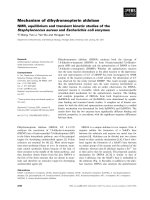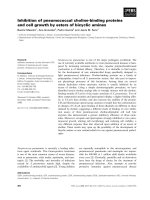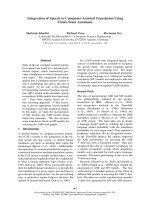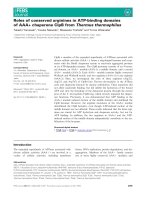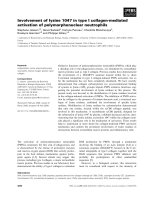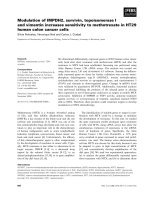Báo cáo khoa học: "Survey of Helicobacter infection in domestic and feral cats in Korea" pdf
Bạn đang xem bản rút gọn của tài liệu. Xem và tải ngay bản đầy đủ của tài liệu tại đây (714.78 KB, 6 trang )
JOURNAL OF
Veterinary
Science
J. Vet. Sci. (2009), 10(1), 67
72
DOI: 10.4142/jvs.2009.10.1.67
*Corresponding author
Tel: +82-2-880-1281; Fax: +82-2-880-1281
E-mail:
Survey of Helicobacter infection in domestic and feral cats in Korea
Heh-Myung Ghil
1
, Jong-Hyeon Yoo
3
, Woo-Sung Jung
1
, Tae-Ho Chung
1
, Hwa-Young Youn
1,2
, Cheol-Yong
Hwang
1,2,
*
1
Department of Veterinary Internal Medicine, and
2
KRF Priority Zoonotic Disease Research Institute, College of Veterinary
Medicine, Seoul National University, Seoul 151-742, Korea
3
BK21 Program of Integrative Network Systems for Veterinarians in Basic Science, Industrial Animals and Preventive
Medicine, Konkuk University, Seoul 143-701, Korea
Discovery of Helicobacter (H.) pylori has led to a fundamental
change in our understanding of gastric diseases in humans.
Previous studies have found various Helicobacter spp. in dogs
and cats, and pets have been questioned as a zoonotic carrier.
The present study surveyed the Helicobacter infections and
investigated the presence of H. felis and H. pylori infections
in domestic and feral cats in Korea. Sixty-four domestic cats
and 101 feral cats were selected from an animal shelter. Saliva
and feces were evaluated by Helicobacter genus-specific
polymerase chain reaction (PCR). Genus-specific PCR
positive samples were further evaluated for H. felis and H.
pylori using specific primer pairs. Thirty-six of 64 (56.3%)
samples from domestic cats and 92 of 101 (91.1%) samples
from feral cats were PCR positive; the positive rate of feces
samples was higher than that of saliva samples in both
groups. H. felis and H. pylori species-specific PCR was
uniformly negative. The prevalence of Helicobacter spp. in
feral cats was approximately two-fold higher than that of
domestic cats. The fecal-oral route may be more a common
transmission route not only between cats but also in humans.
Keywords:
cat, Helicobacter, prevalence, zoonosis
Introduction
Since the discovery of Helicobacter (H.) pylori [28],
gastritis has been studied from a whole new perspective. To
date, spiral bacteria other than H. pylori found in stomach
of humans, animals, dogs and cats have been considered a
potential reservoir of zoonosis [7-9,13,17,19,20,31,32,36,
41,44]. Two gastric Helicobacters, H. heilmannii and H.
felis, are mostly associated with human gastric disease
[14]. Nevertheless, eight other enterohepatic Helicobacters
(H. canis, H. pullorum, H. cinaedi, H. fennelliae, H.
canadensis, H. winghamensis, H. westmaedi, and H.
rappini) have been isolated from humans [10].
In humans, Helicobacter spp. infections are associated
with gastrointestinal diseases, cancers, and the
immunocompromised. In dogs and cats, however, clinically
healthy hosts are typically found. While H. felis is
implicated as a potential pathogen in humans, many other
species are still under research [14].
The route of transmission of Helicobacter spp. is
uncertain, but is known to spread by direct contact. Oral-
oral, gastro-oral, and fecal-oral routes are all possible [2].
Iatrogenic H. pylori infection transmitted by the endoscope
or by contact with gastric fluid also has been reported [43].
H. pylori infection is predominant in the developing world,
and low socio-economic status is associated with increased
prevalence of the infection [27]. Fecal contamination of
common sources including water [16] and soil [15] has been
implicated in spread of the infection. This is supported by
the findings that H. pylori infection rates are higher in
developing countries, where untreated water and inadequately
prepared vegetables contaminated with soil are common
[4,15]. In animals, the DNA of Helicobacter spp. has been
detected from sources other than gastric tissues, which
include vomitus and saliva [37], dental plaques [37], and
feces [18].
In Korea, Helicobacter spp. has been studied in many
animals, for example, dogs [1,17,18,30,33,34], cats [17,22],
pigs [35], mice [21], and Mongolian gerbils [24,25]. The
DNA of several species of Helicobacter has been detected.
‘H. heilmannii’, formerly named Gastrospirillum hominis
in humans [29], is the most predominant species known in
cats [5,7,17,31,36,41]. H. felis [5,20,32,36,41] and H. canis
[8,9] are also detected in cats. H. pylori was isolated from
a group of cats from a commercial vendor of research
animals [11,12], and the bacterial DNA has been detected
in bile of cats [3]. In studies where specific pathogen free cats
were experimentally inoculated with H. pylori or H. felis, the
68 Heh-Myung Ghil et al.
Target gene Primer sequences Product (bp)
H
. spp. 16S rRNA
H
. pylori urease B
H
. felis urease B
F: 5’-GCT ATG ACG GGT ATC C -3’
R: 5’-GAT TTT ACC CCT ACA CCA -3’
F: 5’-GGA ATT CCA GAT CTA TGA AAA AGA TTA GCA GAA AAG -3’
R: 5’-GGA ATT CGT CGA CCT AGA AAA TGC TAA AGA GTT G -3’
F: 5’-ATG AAA CTA ACG CCT AAA GAA CTA G -3’
R: 5’-GGA GAG ATA AAG TGA ATA TGC GT -3’
400
1,707
1,150
F: forward, R: reverse.
Tabl e 1 . Primer sequences for Helicobacter (H.) spp. polymerase chain reaction
bacteria induced mild gastritis associated with lymphoid
follicles, with no gastric erosions or ulcers evident during
upper gastrointestinal endoscopy or at necropsy [38,39].
The present study was surveyed the prevalence of
Helicobacter infection and the specific presence of H. felis
and H. pylori infection, as a means of clarifying the possible
role of domestic and feral cats in Korea as a zoonotic source.
Materials and Methods
Animals and sampling
Saliva and feces samples of 165 domestic and feral cats
were obtained. Cats were grouped by environmental
criteria; domestic cats were those that were almost
exclusively kept indoors and feral cats being those that had
been captured roaming wild in suburban areas. In Korea,
government policy dictates that overpopulating feral cats
are euthanized to preserve the wild life in suburban forests.
During weekly visits to an animal shelter operated by the
Korea Animal Rescue and Management Association,
saliva and feces feral cats (n = 101; 55 females, 46 males)
were obtained. Ages and health status of the cats were not
ascertained. Domestic cats (n = 64; 28 females, 36 males)
were either admitted to the Veterinary Medical Teaching
Hospital of Seoul National University (Korea) or were the
pets of staff members. The cats had an average age of 3.1
years (range 3 months to 12 years). Twenty-three cats were
healthy and 41 were clinically ill; of the latter, the clinical
signs varied from simple anorexia to hepatic lipidosis,
feline lower urinary tract disease, renal failure, diabetes
mellitus, and lymphoma. Feces and saliva samples taken
from each cat by swabbing with sterilized cotton swabs
were merged in 500 μl of autoclaved phosphate buffered
saline. DNA was extracted from 20 μl of each sample using
DNeasy Tissue Kit (Qiagen, USA). The DNA samples
eluted 100-200 μl were stored at -20
o
C until required.
Helicobacter genus-specific polymerase chain reaction
(PCR)
Helicobacter 16S rRNA gene was amplified from each
DNA sample using c97 and c98 primers (Table 1) [10]. The
final reaction volume of 25 μl contained 2 μl of DNA sample,
12.5 pmole of each primer, ×1 PCR buffer (Takara Bio,
Korea), 200 μM of deoxyribonucleoside triphophates
mixture (Takara Bio, Korea), and 0.75 U of recombinant Taq
DNA polymerase (Takara Bio, Korea). The PCR cycle was
94
o
C for 2.5 min followed by 40 cycles of denaturation at
94
o
C, annealing at 50
o
C, extension at 72
o
C for 1 min each,
and a final extension at 72
o
C for 15 min [17]. PCR was
performed using a PC808 programmed temperature control
system (Astec, Japan). PCR products were electrophoresed
on ethidium bromide stained 1.5% w/v agarose gels in ×0.5
TBE buffer. The separated products were visualized on
ultraviolet light illuminator. PCR sensitivity and specificity
of fecal samples has been previously evaluated [18].
H. pylori and H. felis specific PCR
H. pylori and H. felis specific PCR was performed with
primers (Table 1) that amplify the urease B gene of H. pylori
and H. felis [31]. Two microliters of each DNA sample was
added to a reaction mixture containing 12.5 pmole of each
primer, ×1 PCR buffer (Takara Bio, Korea), 200 μM of
deoxyribonucleoside triphophates mixture (Takara Bio,
Korea), and 0.75 U of recombinant Taq DNA polymerase
(Takara Bio, Korea) to produce a total volume of 25 μl. For
H. pylori specific PCR, samples were heated to 95
o
C for 5
min and 57
o
C for 5 min once, followed by 35 cycles of
extension at 72
o
C for 1 min, denaturation at 94
o
C for 1 min,
annealing at 72
o
C for 2 min, and a final extension at 72
o
C
for 10 min [41]. The positive control (isolates purchased
from the American Type Culture Collection; ATCC, USA)
and the negative control (sterile distilled water) were carried
out with every PCR. For H. felis specific PCR, samples were
heated to 94
o
C for 2.5 min once, followed by 40 cycles of
denaturation at 94
o
C, annealing at 47
o
C, extension at 72
o
C
for 1 min each, with a final extension at 72
o
C for 15 min. The
positive control (H. felis ATCC 49179) and the negative
control (sterile distilled water) were carried out with every
PCR. PCR products were electrophoresed on ethidium
bromide stained 1.5% w/v agarose gels in ×0.5 TBE buffer.
The separated PCR products were visualized using an
ultraviolet light illuminator.
Helicobacter infection in domestic and feral cats 69
Fig. 1. PCR amplication of Helicobacter (H.) spp. genus- specific 16S rRNA gene. DNA molecular weight standard marker (Lane 1),
H
. felis positive control (ATCC 49179) of DNA product at 400 bps (Lane 2), negative control (Lane 3), feces of feral cats no.92-101
(Lanes 4-13) are shown.
Domestic cats (%) Feral cats (%)
Saliva
Feces
Saliva or Feces
Total
17
29
36
64
(26.6)
(45.3)
(56.3)
(100)
48
85
92
101
(46.5)
(84.2)
(91.1)
(100)
Tabl e 2 . PCR prevalence of
H
elicobacte
r
spp. infection in
domestic and feral cats
Fig. 2. PCR amplication of Helicobacter (H.) felis urease B gene
fragment. DNA molecular weight standard marker (Lane 1),
H
.
f
elis positive control (ATCC 49179) of DNA product at 1,150
b
ps
(Lane 2), negative control (Lane 3), feces of domestic cats no. 12,
14, 16 (Lanes 4-6) are shown. All saliva and feces samples o
f
p
ositive Helicobacter genus-specific PCR were H. felis negative.
Purifying and nucleotide sequence analysis
A specific sized PCR product was extracted using a
MEGAquick-spin gel extraction kit (Intron, Korea) to
confirm the identity of the target gene PCR product.
Purified PCR products were analyzed using an ABI 3100
automatic sequence analyzer (Applied Biosystems, USA).
Results
Helicobacter genus-specific PCR
On Helicobacter genus-specific PCR for 16s rRNA gene,
36 (56.3%) from 64 domestic cats were positive, and 92
(91.1%) from 101 feral cats were positive on either saliva
or feces samples (Fig. 1). In domestic cats, 17 (26.6%)
saliva samples and 29 (45.3%) feces samples were
positive. Infection rates were higher in feral cats with 47
(46.5%) saliva samples and 85 (84.2%) feces samples
being positive (Table 2). Among the 64 domestic cats for
which the clinical status was known, 36 (56.3%) were
positive for Helicobacter spp. infection. Clinically ill cats
had a Helicobacter spp. infection rate of 63.4% (26/41),
compared to 43.5% (10/23) of healthy cats, which was not
statistically significant. Ill cats were not especially prone to
gastrointestinal diseases, and their diagnoses mainly
involved anorexia with or without hepatic lipidosis, feline
urologic syndrome, diabetes mellitus, renal failure, feline
infectious peritonitis, lymphoma, and otitis.
H. pylori and H. felis specific PCR
Species-specific PCR was performed on 17 saliva
samples and 29 feces samples from the domestic cats and
47 saliva samples and 85 feces samples from the feral cats,
which showed a positive result on genus-specific PCR. In
H. felis specific PCR, which amplified a 1,200 bp fragment
in the positive control (ATCC 49179), none of the samples
were positive (Fig. 2). Also, no samples were positive on
H. pylori specific PCR, which revealed a 1,700 bp
fragment on the positive control (SS1 strain) (Fig. 3).
70 Heh-Myung Ghil et al.
Fig. 3. PCR amplication of Helicobacter (H.) pylori urease B
gene fragment. DNA molecular weight standard marker (Lane
1), H. pylori positive control of DNA product at 1,707 bps (Lane
2), negative control (Lane 3), feces of feral cats no.71-73 (Lane
4-6) are shown. All saliva and feces samples of positive
Helicobacter genus-specific PCR were H. pylori negative.
Sequence analysis
Direct sequencing of the PCR product of the specific 400
bp band confirmed the amplified DNA fragments to be
from the genus Helicobacter. Direct sequencing of the
genus specific PCR product was performed on two
randomly selected feces samples. One of the sequencing
results was 100% identical with H. canis 16S rRNA gene.
It displayed 99% similarity to the sequence of Helicobacter
spp. ‘feline isolate’ 16S rRNA, H. canis strain Lausanne
16S rRNA, and H. canis NCTC 12220 16S rRNA. The
other sequencing result resulted in 97% homology to H.
canis strain MIT 51402, H. canis strain ATCC 51401, H.
cholecystus strain ATCC 700242, and H. bilis strain FL56.
Discussion
The prevalence of Helicobacter spp. between 64
domestic and 101 feral cats in Korea was compared in this
study. Prevalence of Helicobacter spp. in either saliva or
feces samples was 91.1% in feral cats and 56.3% in
domestic cats suggesting that feral cats under shelter
environments are at greater risk of Helicobacter spp.
infection. The precise route of transmission of Helicobacter
spp. is yet unknown, but other than fecal-oral or oral-oral
routes, gastric juice after vomiting as the natural route of
transmission is considered [2]. This gastro-oral hypothesis
seems to be convincing considering the fact that the
infection is typically acquired in early childhood in
humans, specifically with epidemiologic vomiting and
childhood overcrowding [2,23]. Moreover, since infection
is predominant in developing countries and among
intimate familial members [26], it seems likely that the cats
in shelter environments are prone to Helicobacter spp.
infection. Positive infection rates were higher on feces
samples in both domestic and feral cats (46.5% and 84.2%,
respectively) than on saliva samples (26.6% and 45.3%,
respectively). This may suggest that under natural
circumstances fecal-oral transmission is more likely than
oral-oral transmission among cats. In a previous study,
only fecal contact remained as a significant risk factor in an
indirect study by questioning, and the seroprevalence for
H. pylori increased significantly with age [6]. Nevertheless,
healthy adult cats vomit naturally on occasion to spit out
hairballs, which makes the gastro-oral route conceivable.
The incidence of positive outcome between saliva and
feces samples were random, meaning positive feces
samples did not always have positive saliva samples, nor
did positive saliva samples not always have positive feces
samples.
Clinical signs were unknown in feral cats, and domestic
cats did not have apparent gastrointestinal signs. Forty-one
domestic cats admitted to the hospital for sickness mostly
had systemic diseases, and gastrointestinal signs were of
simple anorexia coupled with stress or secondary mucosal
bleeding due to azotemia. In clinically healthy domestic
cats the rate of Helicobacter spp. infection was 43.5%
(10/23) and in clinically ill domestic cats the rate was
63.4% (26/41). Correlation between the infection rate and
the clinical illness including gastrointestinal signs was not
confirmative in this study due to the small number of cats
involved. Further study of a larger cat population would be
needed.
In species-specific studies, neither H. felis nor H. pylori
were found. This is consistent with the results of some
previous studies. A Swiss study of 58 cats reported that no
amplification of H. felis or H. pylori were detected in PCR
[31]. However, other studies that utilized PCR for
examination of gastric biopsy samples reported H. felis
was in four of 17 [41], two of 21 [17], and one of 15 [5] cats,
and one of 10 cheetahs [42]. Although the numbers of cats
in the present study was higher than in previous studies, not
a single H. felis positive sample was evident. Presently,
direct sequencing of two 16S rRNA gene-specific PCR
products was conducted from purified isolates of
genus-specific PCR. One of the two products displayed
100% similarity to a H. canis 16S rRNA sequence of 336
base pairs. The 16S rRNA sequences of H. felis and those
of H. bizzozeronii and H. salomonis display 98.2-100%
similarity [19], and H. canis differs by 8.1-10.1% from
these species [40]. This implies that there is a significant
genetic difference within the 16S rRNA gene of these
Helicobacter species. H. canis also has been reported in
Helicobacter infection in domestic and feral cats 71
cats in the United States [8,9].
In Korea, Helicobacter spp. studies in cats [17,22] have
been fewer and not perceived as urgent a public health
issue as similar studies conducted in dogs [1,17,30,33,34].
However, given the burgeoning population of domestic
cats in Korea, and the likelihood that many of these cats are
kept indoors in close contact with adults and children,
careful study of the zoonotic potential of cats is warranted.
While cats have not been regarded as a potential zoonotic
threat for Helicobacter infections, the results of this study
show prompt a re-examination of that view. It is suggested
that care be taken especially when handling feces of
domestic cats.
Acknowledgments
This work was supported by the Research Institute of
Veterinary Science, College of Veterinary Medicine, Seoul
National University and Korean Research Foundation
Grant (KRF-005-E00078).
References
1. An JH, Nam HW, Han JH, Kim D. The detection of
Helicobacter-like organisms in dogs. Korean J Vet Clin Med
1999, 16, 281-288.
2. Axon ATR. Is Helicobacter pylori transmitted by the
gastro-oral route? Aliment Pharmacol Ther 1995, 9, 585-588.
3. Boomkens SY, Kusters JG, Hoffmann G, Pot RGJ, Spee
B, Penning LC, Egberink HF, Van den Ingh TS,
Rothuizen J. Detection of Helicobacter pylori in bile of
cats. FEMS Immunol Med Microbiol 2004, 42, 307-311.
4. Brown LM. Helicobacter pylori: epidemiology and routes
of transmission. Epidemiol Rev 2000, 22, 283-297.
5. Chisholm SA, Owen RJ. Development and application of a
novel screening PCR assay for direct detection of
‘Helicobacter heilmannii'-like organisms in human gastric
biopsies in Southeast England. Diagn Microbiol Infect Dis
2003, 46, 1-7.
6. De Schryver A, Van Winckel M, Cornelis K, Moens G,
Devlies G, De Backer G. Helicobacter pylori infection:
further evidence for the role of feco-oral transmission.
Helicobacter 2006, 11, 523-528.
7. Dieterich C, Wiesel P, Neiger R, Blum A, Corth
ésy-
Theulaz I. Presence of multiple "Helicobacter heilmannii"
strains in an individual suffering from ulcers and in his two
cats. J Clin Microbiol 1998, 36, 1366-1370.
8. Foley JE, Marks SL, Munson L, Melli A, Dewhirst FE,
Yu S, Shen Z, Fox JG. Isolation of Helicobacter canis from
a colony of bengal cats with endemic diarrhea. J Clin
Microbiol 1999, 37, 3271-3275.
9. Foley JE, Solnick JV, Lapointe JM, Jang S, Pedersen NC.
Identification of a novel enteric Helicobacter species in a
kitten with severe diarrhea. J Clin Microbiol 1998, 36,
908-912.
10. Fox JG. The non-H pylori helicobacters: their expanding
role in gastrointestinal and systemic diseases. Gut 2002, 50,
273-283.
11. Handt LK, Fox JG, Dewhirst FE, Fraser GJ, Paster BJ,
Yan LL, Rozmiarek H, Rufo R, Stalis IH. Helicobacter
pylori isolated from the domestic cat: public health
implications. Infect Immun 1994, 62, 2367-2374.
12. Handt LK, Fox JG, Stalis IH, Rufo R, Lee G, Linn J, LI
X, Kleanthous H. Characterization of feline Helicobacter
pylori strains and associated gastritis in a colony of domestic
cats. J Clin Microbiol 1995, 33, 2280-2289.
13. H
änninen ML, Happonen I, Saari S, Jalava K. Culture
and characteristics of Helicobacter bizzozeronii, a new
canine gastric Helicobacter sp. Int J Syst Bacteriol 1996, 46,
160-166.
14. Heilmann KL, Borchard F. Gastritis due to spiral shaped
bacteria other than Helicobacter pylori: clinical, histological,
and ultrastructural findings. Gut 1991, 32, 137-140.
15. Hopkins RJ, Vial PA, Ferreccio C, Ovalle J, Prado P,
Sotomayor V, Russell RG, Wasserman SS, Morris JG Jr.
Seroprevalence of Helicobacter pylori in Chile: vegetables
may serve as one route of transmission. J Infect Dis 1993,
168, 222-226.
16. Hulten K, Han SW, Enroth H, Klein PD, Opekun AR,
Gilman RH, Evans DG, Engstrand L, Graham DY,
El-Zaatari FA. Helicobacter pylori in the drinking water in
Peru. Gastroenterology 1996, 110, 1031-1035.
17. Hwang CY, Han HR, Youn HY. Prevalence and clinical
characterization of gastric Helicobacter species infection of
dogs and cats in Korea. J Vet Sci 2002, 3, 123-133.
18. Hwang CY, Youn HY, Han HR. Development of non-
invasive fecal PCR assay for detecting the Helicobacter
species infection in dogs. J Vet Clin 2002, 19, 295-298.
19. Jalava K, Kaartinen M, Utriainen M, Happonen I,
Hanninen ML. Helicobacter salomonis sp. nov., a canine
gastric Helicobacter sp. related to Helicobacter felis and
Helicobacter bizzozeronii. Int J Syst Bacteriol 1997, 47,
975-982.
20. Jalava K, ON SL, Vandamme PA, Happonen I, Sukura A,
H
änninen ML. Isolation and identification of Helicobacter
spp. from canine and feline gastric mucosa. Appl Environ
Microbiol 1998, 64, 3998-4006.
21. Kim BH, Won YS, Lee CH, Hyun BH, Kim DY, Choi YK.
Inflammatory large bowel disease due to Helicobacter
hepaticus infection in BALB/cA-Hfh11
nu
mice. Korean J
Lab Anim Sci 1998, 18, 143-146.
22. Kim SK, Cho SJ, Kim O. Detection and identification of
secreting Helicobacter species from cats. Lab Anim Res
2006, 22, 243-247.
23. Kivi M, Tindberg Y. Helicobacter pylori occurrence and
transmission: a family affair? Scand J Infect Dis 2006, 38,
407-417.
24. Lee JU, Jung K, Kim O. Absence of vertical transmission
of Helicobacter pylori in an experimental murine model. J
Vet Sci 2006, 7, 225-228.
25. Lee JU, Kim O. Natural maternal transmission of H. pylori
in Mongolian gerbils. World J Gastroenterol 2006, 12,
5663-5667.
26. Magalh
ães Queiroz DM, Luzza F. Epidemiology of
Helicobacter pylori infection. Helicobacter 2006, 11, 1-5.
27. Malaty HM, Kim JG, Kim SD, Graham DY. Prevalence
72 Heh-Myung Ghil et al.
of Helicobacter pylori infection in Korean children: inverse
relation to socioeconomic status despite a uniformly high
prevalence in adults. Am J Epidemiol 1996, 143, 257-262.
28. Marshall BJ, Warren JR. Unidentified curved bacilli in the
stomach of patients with gastritis and peptic ulceration.
Lancet 1984, 1, 1311-1315.
29. McNulty CAM, Dent JC, Curry A, Uff JS, Ford GA,
Gear MW, Wilkinson SP. New spiral bacterium in gastric
mucosa. J Clin Pathol 1989, 42, 585-591.
30. Nam HW, Kim D. Prevalence of Helicobacter species
infection in dogs. Korean J Vet Res 2000, 40, 747-753.
31. Neiger R, Dieterich C, Burnens A, Waldvogel A, Corth
ésy-
Theulaz I, Halter F, Lauterburg B, Schmassmann A.
Detection and prevalence of Helicobacter infection in pet cats.
J Clin Microbiol 1998, 36, 634-637.
32. Norris CR, Marks SL, Eaton KA, Torabian SZ, Munn
RJ, Solnick JV. Healthy cats are commonly colonized with
"Helicobacter heilmannii" that is associated with minimal
gastritis. J Clin Microbiol 1999, 37, 189-194.
33. Park JH, Lee BJ, Kim CK, Park TK, Park JH, Kim CH,
Li GX, Lee YS. Pathological examination of stomachs from
beagle dogs spontaneously infected with Gastrospirillum sp.
Korean J Lab Anim Sci 1998, 14, 121-126.
34. Park JH, Park HM, Seok SH, Cho SA, Lee HY, Kim DJ,
Park JH. Prevalence and pathological characteristics of
Helicobacter spp. in gastric mucosa of domestic pet dogs.
Korean J Lab Anim Sci 2002, 18, 120-124.
35. Park JH, Seok SH, Cho SA, Baek MW, Lee HY, Kim DJ,
Park JH. The high prevalence of Helicobacter sp. in porcine
pyloric mucosa and its histopathological and molecular
characteristics. Vet Microbiol 2004, 104, 219-225.
36. Priestnall SL, Wiinberg B, Spohr A, Neuhaus B, Kuffer M,
Wiedmann M, Simpson KW. Evaluation of "Helicobacter
heilmannii" subtypes in the gastric mucosas of cats and dogs.
J Clin Microbiol 2004, 42, 2144-2151.
37. Recordati C, Gualdi V, Tosi S, Facchini RV, Pengo G,
Luini M, Simpson KW, Scanziani E. Detection of
Helicobacter spp. DNA in the oral cavity of dogs. Vet
Microbiol 2007, 119, 346-351.
38. Simpson KW, Strauss-Ayali D, Scanziani E, Straubinger
RK, McDonough PL, Straubinger AF, Chang YF,
Domeneghini C, Arebi N, Calam J. Helicobacter felis
infection is associated with lymphoid follicular hyperplasia
and mild gastritis but normal gastric secretory function in
cats. Infect Immun 2000, 68, 779-790.
39. Simpson KW, Strauss-Ayali D, Straubinger RK,
Scanziani E, McDonough PL, Straubinger AF, Chang YF,
Esteves MI, Fox JG, Domeneghini C, Arebi N, Calam J.
Helicobacter pylori infection in the cat: Evaluation of gastric
colonization, inflammation and function. Helicobacter 2001,
6, 1-14.
40. Solnick JV, Schauer DB. Emergence of diverse Helicobacter
species in the pathogenesis of gastric and enterohepatic
diseases. Clin Microbiol Rev 2001,
14, 59-97.
41. Strauss-Ayali D, Scanziani E, Deng D, Simpson KW.
Helicobacter spp. infection in cats: evaluation of the humoral
immune response and prevalence of gastric Helicobacter spp.
Vet Microbiol 2001, 79, 253-265.
42. Terio KA, Munson L, Marker L, Aldridge BM, Solnick
JV. Comparison of Helicobacter spp. in Cheetahs (Acinonyx
jubatus) with and without gastritis. J Clin Microbiol 2005,
43, 229-234.
43. Tytgat GN. Endoscopic transmission of Helicobacter
pylori. Aliment Pharmacol Ther 1995, 9 (Suppl 2), 105-110.
44. Wiinberg B, Spohr A, Dietz HH, Egelund T, Greiter-
Wilke A, McDonough SP, Olsen J, Priestnall S, Chang
YF, Simpson KW. Quantitative analysis of inflammatory
and immune responses in dogs with gastritis and their
relationship to Helicobacter spp. infection. J Vet Intern Med
2005, 19, 4-14.



